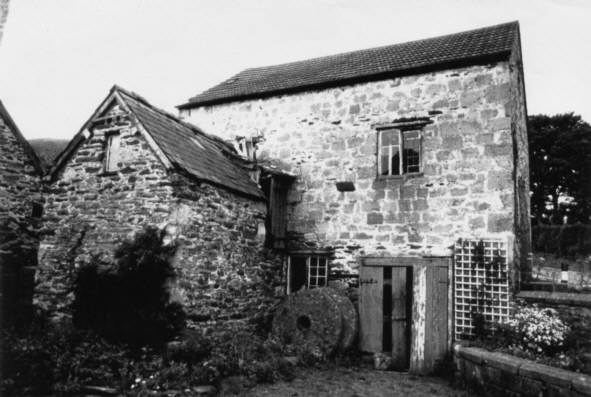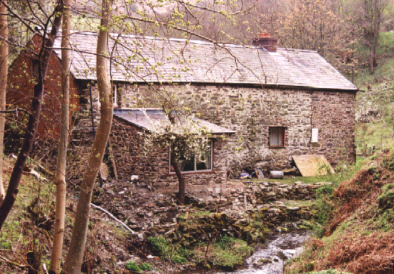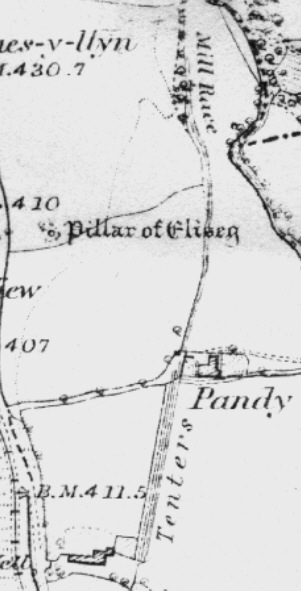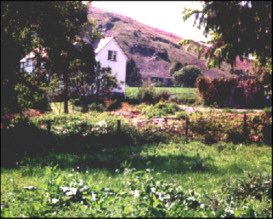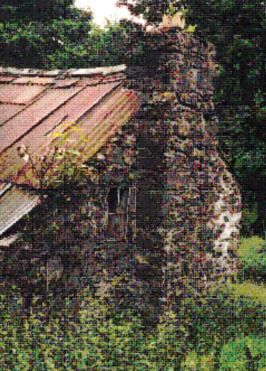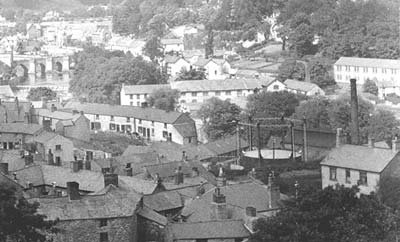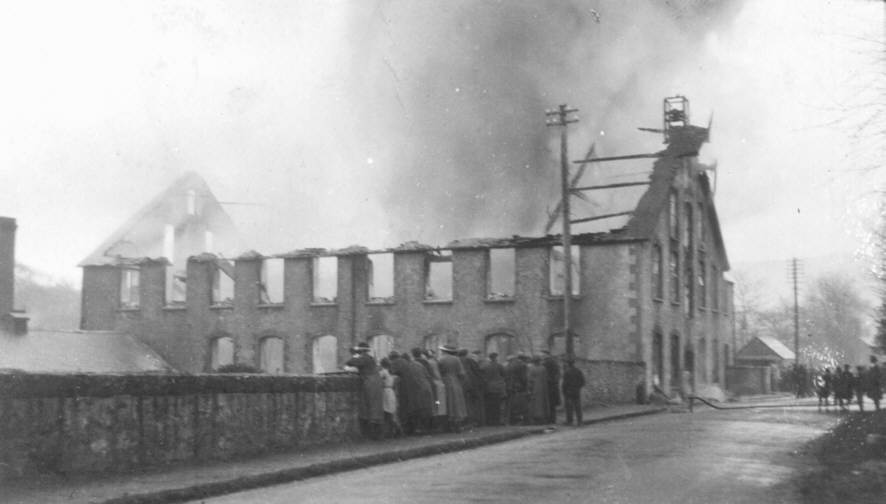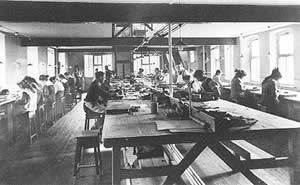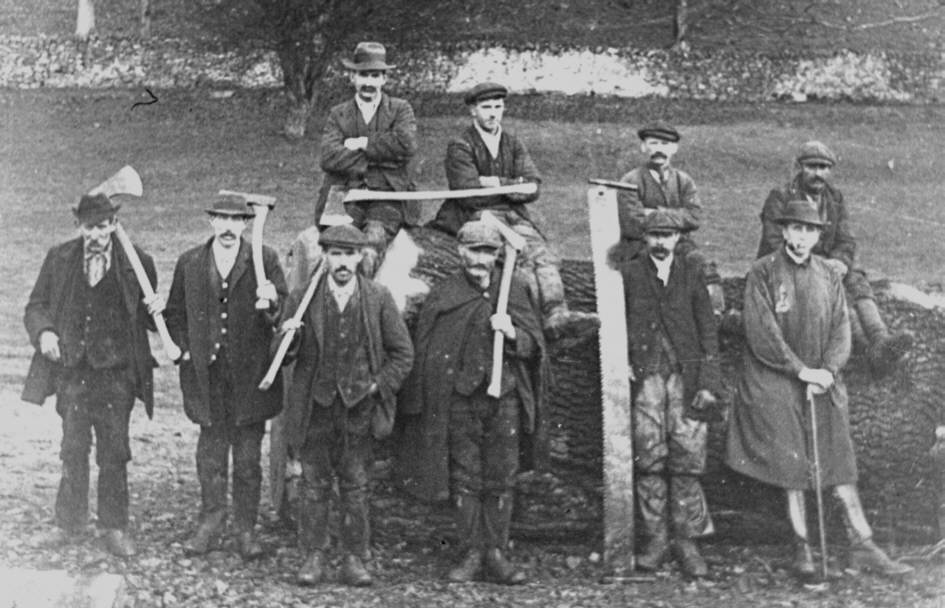| Over the years, Llantysilio
and Llangollen have been the homes of numerous industries,
primarily the manufacture of wool and flannel but also
corn milling and brewing. The Romans
first introduced the technology of the watermill. Corn
Mills were clearly important because the grinding of grain was
essential to life. Only in the late 19th
century did the watermill begin to disappear from our towns
and countryside. Sadly, all of the mills are now
silent or converted to other uses and the breweries are dry.
The principal industry
of Llangollen and Llantysilio is now tourism.
|
| Corn Milling
|
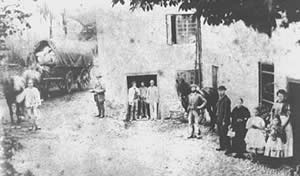 Llangollen
Mill Llangollen
Mill
Llangollen Mill was a corn mill originally
built by the Cistercian monks of Valle Crucis and is mentioned
in a 13th century document dealing with a fishing dispute
between the freemen of Llangollen and the Abbot of Valle
Crucis. The mill was re-built in 1786 mainly of local stone.
At the end of the 18th century John Jones was the miller,
marrying in 1795 Mary Bowen of Dinbren.
John Jones died in 1812, but in 1830 a
Thomas Jones is shown as miller in Llangollen Ė whether he
was a descendent is unknown. In the 1840s Edward Owens
occupied the mill, followed by Samuel Parry in the 1850s and
early 60s. The family firm of William Jones and Son took over
the mill in 1864 and the mill was used solely for grinding
corn until 1895, when changing times and conditions
necessitated the decision to become a provender mill.
The mill continued to operate for another 80
years, finally closing in 1974. The property remained within
the Jones family for a further 20 years or so, during which
time it was leased to Llangollen Weavers and later to an
antiques showroom and gift shop. The Corn Mill then became a
restaurant and pub.
|
|
top of page |
|
Pentrefelin Mill was the medieval corn mill
of Valle Crucis Abbey. It was recorded in 1596 in documents
relating to land previously belonging to the Abbey and in 1606
was rented to Richard Mathew. Rebuilt in 1702, census records
show that in 1891 the mill was worked by Thomas Jones, Miller,
and his wife and William Hughes aged 14 years, a mill labourer.
In 1987 it was restored and converted into a family home.
Inside, some of the workings remain in situ.
|
|
|
|
With itís leet, mill pond and overshot
water wheel, Melin Eglwyseg was typical of many thousands of
small upland mills which once existed in Wales. The
prefabricated cast-iron parts demonstrate the central role of
water power in the early industrial age.
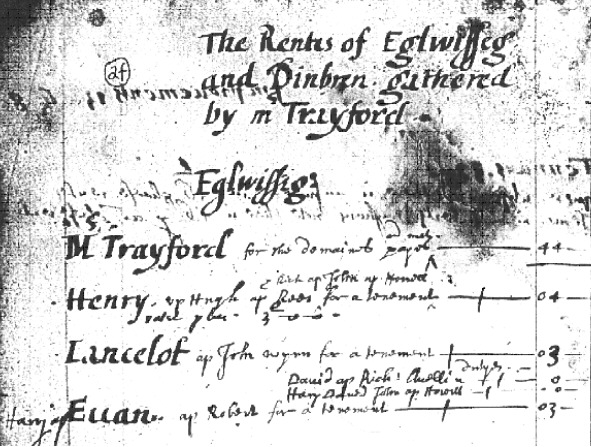
As early as 1626 rental records for the
Wynnstay Estate list an M. Trayford as paying an annual rent
for 'the domain and mill' in Eglwyseg. The mill was
a flour mill that remained in operation until the end of the
19th century. Now a private house the mill
wheel remained on the
end of the building until the late 1960s when it was torn off
in a storm.
|
|
|
The corn mill in Rhewl belonged to the
Edwards family in the middle of the 19th century.
However, the dam and the reservoir that fed the mill appear on
an estate map of 1783, indicating that the mill had been in
use for at least 70 years prior to this. The dam was 12 feet
high and the remains of the stone walls still bear witness to
an impressive feat of engineering.
|
|
|
The other traditional use for mills in
Llangollen and Llantysilio was in the wool and cotton
industries. The original mills were the Pandai or Fulling
Mills, used to strengthen wool before it was made into
clothing or blankets. Cleaning and
stabilising cloth was an important activity in medieval times.
Cloth was beaten in a water and clay (Fullers Earth) filled
trough and stretched tightly on tenter frames to bleach in the
sun. The Cistercian monks of Valle
Crucis undoubtedly brought with them an increase in the use of
wool and there are at least two old Pandys to be found in
Llantysilio.
The increase in demand and the industrial
revolution brought larger scale operations to Llangollen with
the development of the Dee Cotton Mills in 1805 and Mile End
Mill.
|
| top of page |
|
Pandy is a 20th century building adjacent to
the site of the original fulling mill of Valle Crucis Abbey. A
ditch/leet was dug (the line of which can be seen), diverting
water from Nant Eglwyseg to power the mill wheel. Rental
documents
from 1606 refer to the fulling activities.
Fulling continued after the monks left, with census records
from 1841 to 1871 showing occupation by fullers.
|
|
|
Hen Bandy (Old Fulling Mill) can be
identified in the records of 1719 but even at this time it was
referred to as the Old Fulling Mill, so it is likely that the
history of
this building goes back even earlier. In fact a medieval
spindle whorl was found on the site. Until the middle of the
19th century there was a third building at Hen Bandy, adjacent
to the stream, undoubtedly the original Mill.
|
|
|
Cotton came to Llangollen in 1805 when Lower
Dee Mill was built, but only lasted 30 years as slumps in the
trade caused successive bankruptcies. The prospering wool
trade with itís mechanical looms took over and the Mill was
bought by Hughes and Roberts in 1835. They expanded into the
Upper Mill in 1855. Both remained in production until 1921
giving Llangollen a 130 year connection with the trade. The
site was later occupied by Cuthberts seed merchants.
|
| top of page |
|
|
Mile End Mill after a fire that happened
shortly before Christmas 1907. Another fire at Mile End
Flannel Mill occurred in 1920. It was attended by both
Llangollen and Wrexham Fire Brigades. The owner S. Lloyd Jones
lost £33,000.
|
 Other
Industries Other
Industries
|
|
Sited on the location of a former woollen
mill, the buildings behind Church St were used by the Llangollen
Tanning Company, established around 1900. The black and white
house was the office for the tannery until it closed
in 1990. Many were not sorry to see it go as the process generated
a smell that was not pleasant.
|
| top of page |
|
|
It is not known exactly when Coward's timber yard first
opened, but by 1891 the business was thriving. Shown on the
right is part of the workforce of Cowardís Timber Company.
Mr Tom Coward, the owner, is on the extreme right.
The business continued until the 1950s (aerial view left).
After closure the buildings of the timber yard were empty for
some time before being demolished. Today the former timber
yard is the site of the Kwik Save supermarket. |
 top of page top of page |
 Llangollen
Mill
Llangollen
Mill